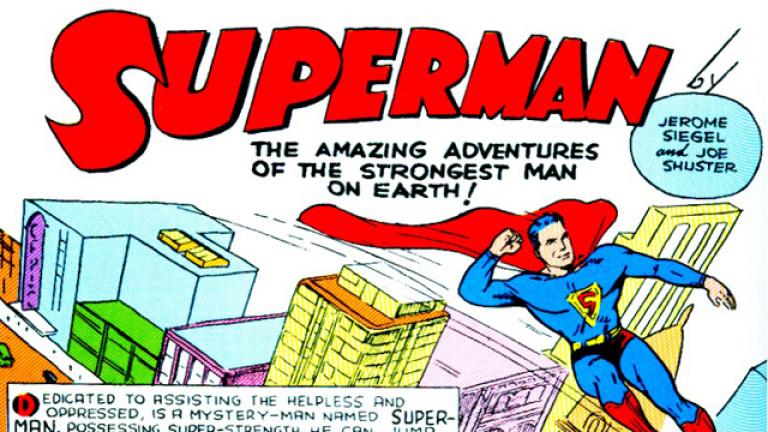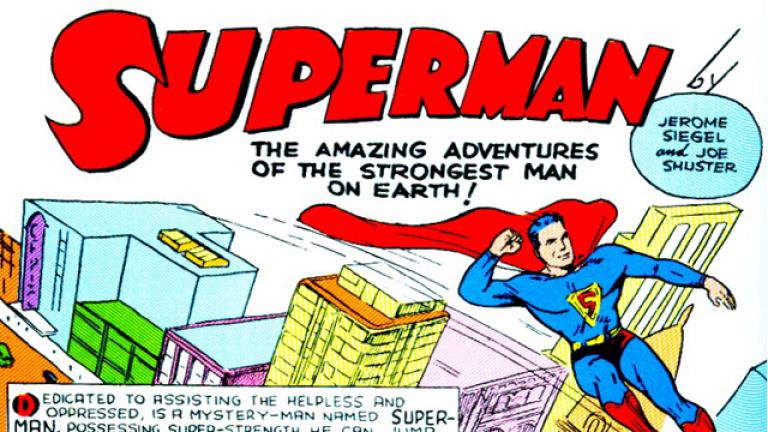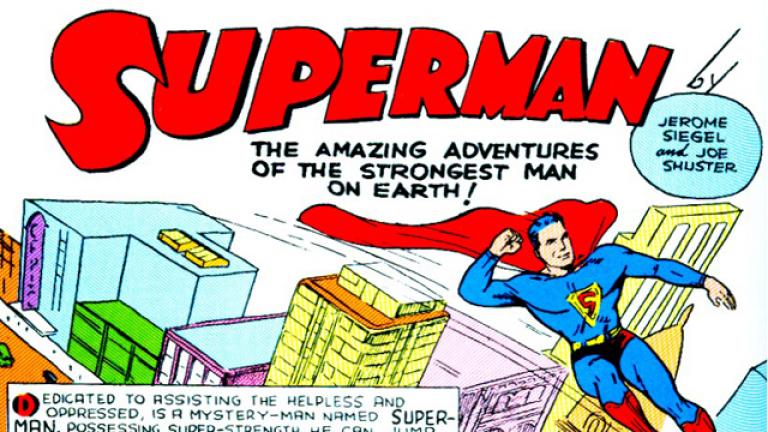The most enduring american hero of the last century is someone who lived half his life in disguise and the other half as the world’s most recognizable man. He is not Jack Kennedy or Joltin’ Joe DiMaggio, Batman or Jerry Seinfeld, although all of them were inspired by him. It was on his muscle- bound back that the iconic comic book took flight and the very idea of the superhero was born. He appeared on more radio broadcasts than Ellery Queen and in more movies than Marlon Brando, who once pretended to be his father. He helped give America the backbone to wage war against the Nazis, the Great Depression, and the Red Menace. He remains an intimate to kids from Boston to Belgrade and has adult devotees who, like Talmudic scholars, parse his every utterance. And he has done it all with an innocence and confi dence that allowed him to appear publicly wearing underpants over full- body tights, and to assume an alter ego who kept pursuing the prettiest girl in town even though he seldom got her.
The most enduring American hero is an alien from outer space who, once he reached Earth, traded in his foreign- sounding name Kal- El for a singularly American handle: Superman.
Ah, you say, the Man of Steel— I know him! But do you really? Do you know the wrenching story of his birth and nurturing at the hands of a parade of young creators yearning for their own absent fathers? The first was the youngest child of Lithuanian immigrants who was devastated when his dad died during a robbery. While there was no bringing back his father and role model, Jerry Siegel did bring to life a hero able not just to run fast and jump high but, as we see early on, to fend off a robber. Who would publish this fanciful tale? How about Jack Liebowitz, a hardheaded comic book entrepreneur whose own dad had died just after he was born and who needed a champion? Whitney Ellsworth, the man who wrote, edited, and produced nearly all the episodes of the 1950s TV show that introduced many baby boomers to this costumed hero, was just fourteen when he lost his forty- five-year-old father to a heart attack. George Reeves, TV’s original Clark Kent and Superman, didn’t even know who his real father was until he was in his twenties. Who better to create the ultimate childhood fantasy figure than men whose childhoods had been stolen from them?
Not just Superman but his rivals, too, were more than they seemed— and more than just fantasy. Many of them were real-world menaces, which made the Superman stories timely and authentic. Superman stood up to Hitler and Stalin before America did. The Metropolis Marvel used his radio broadcast to expose the savagery of the Ku Klux Klan, and in his comic books he upended slumlords and wife- beaters. Lex Luthor, Superman’s most persistent foe, likely came from Jerry Siegel’s boyhood. The day after Jerry’s father died, his hometown newspaper published a letter denouncing the kind of vigilante justice that would become Superman’s early signature. The letter writer: A. L. Luther.
The superhero never revealed how he voted, but during the Great Depression he was a New Dealer hell- bent on truth and justice, and during the Reagan Revolution he was a patriot trumpeting the American way. His sex life underwent an even more drastic about-face: from celibate to satisfi ed husband. There is one more thing that even his most fervent fans may not know about the Man of Steel: He is Jewish.
I have been captivated by Superman ever since I wrote my first book, the life story of the public relations pioneer and master manipulator Edward L. Bernays. Borrowing ideas from his uncle Sigmund Freud, Bernays single- handedly shaped many of our political and cultural appetites— from sweetening sour politicians like Calvin Coolidge to selling America on the European tenor Enrico Caruso. Negro Leagues strikeout king Leroy “Satchel” Paige, the subject of my most recent book, borrowed Bernays’s techniques in crafting his own eye-popping legend. Paige and Bernays got me wondering: Why does America embrace the heroes it does? What do our choices say about them and, more important, about us? There’s no better way to understand modern-day heroes than to look at Superman, the superhero who tapped into the American psyche more effectively than anyone else and, as a result, has lasted longer than all of them.
Clearly there was a serious story here, but for me the other appeal of writing this book was getting to be ten again. I had grown up reading Superman comics and watching nearly all 104 episodes of Adventures of Superman on TV. I sat mesmerized by his movies and pondered: What would it feel like to actually take flight? Superman was comfort food for my spirit, and writing this book let me partake of that comfort all over again. It also let me imagine what Superman did between adventures, when he doffed his cape and sprawled out on the couch.
Okay, so I still cared about Superman, but did anyone else? Sure, he was a big deal when I was coming of age in the 1960s, but I assumed he was passé in the virtual realities of the new millennium. Then I started paying attention. My four-year-old nephew showed up one night wearing a Superman shirt. My sixteen-year-old stepdaughter told me how, when she was four, she had trick- or- treated dressed not as Supergirl but as Superman. My oldest friend’s fourteen-year-old daughter showed me her DVD collection of Smallville, a show I had never heard of that, for ten seasons, has chronicled the adventures of a young Clark Kent. The final test came on Halloween, when merchants in my hometown of Lexington, Massachusetts, hand out candy all afternoon, packing sidewalks with costumed kids who provide the perfect sampling with which to judge who’s hot in the world of heroes. Spider-Man did well, with half a dozen children dressed in webbed costumes, but the hands- down winner was the blue tights, red cape, and bright yellow S of Superman.
I still had doubts, but they had changed from whether anyone cared to why. Why did Senator Barack Obama pose in front of a Superman statue and later, just before his election as president, joke that he, too, came from Krypton? Surely he understood better than anyone the value of bonding to such a symbol of strength and honor. Why is the Man of Steel as popular today as he was in my boyhood and in every era back to his begetting in the 1930s? That is more than we can say for Jim Thorpe or Dwight Eisenhower, the Phantom, the Lone Ranger, or Tarzan the Ape Man. By the time of his death, even a brilliant pitcher and consummate character like Satchel Paige had become a vague if nostalgic memory for most. Heroes, understandably, are woven into their time and seldom last far beyond it. How had Superman broken the mold?
To answer those questions, I did what any journalist would: I asked smart people who ought to know. I did more than two hundred interviews, starting with historians, clerics, and psychologists who have written and lectured about Superman’s godlike attributes, his corrupting influences, and why children and their grandparents continue to embrace him. I spoke with writers and artists who brought Superman to life in comic books, comic strips, novels, and graphic novels, as well as on radio, TV, film, and animation. Ninety- two- year- old ghostwriter Alvin Schwartz told me that he wasn’t supposed to tell anyone that he was the man behind the newspaper strip, but then The New York Times outed him. Jack Larson and Noel Neill explained why they initially did all they could to escape their Jimmy Olsen and Lois Lane personas from the wildly popular Adventures of Superman, but now— like Superman’s other aging midwives— they relish the attention the connection still brings. Aaron Smolinski recounted the way kids teased him for appearing naked as baby Clark in Superman: The Movie and the way people still ask, “How did you lift the truck?” “I say, ‘I’m Superman.’ ”
I visited Superman’s publisher in New York. I went to his movie studio in California and his hometown of Cleveland. I talked to fanatic fans and casual ones, adolescents and octogenarians, here and abroad. They all agreed with Donald Wurzelbacher of Cincinnati that Superman is “the godfather of superheroes . . . the original, first, and greatest.”
I listened to hour after hour of Superman’s old radio broadcasts and watched his early and recent TV shows, cartoons, and films. I read everything I could find about him in books, magazines, and newspapers, where columnists loved to quote him in the financial and editorial sections as well as in the comics, in tabloids like the New York Post and high- minded broadsheets like The New York Times. I pored over thousands of pages of public records, and others that have never been released, from the ongoing lawsuit against Superman’s publisher by his creators’ heirs. I read the unpublished memoirs of Jerry Siegel and Jack Liebowitz, Superman’s originator and patron, and talked to their friends and relatives. I reviewed yellowing police files and coroner’s reports on George Reeves, the TV Man of Steel, with forensic experts and researchers who have spent a lifetime looking into his death. I began by worrying whether, given all that has been written on Superman, I would have anything new to say. I ended by worrying how to fit into a single manuscript all I have to say on this unambiguous hero who is as much a part of our communal DNA as Paul Bunyan or Huckleberry Finn.
So how has Superman managed to thrive for nearly seventy-five years?
It starts with the intrinsic simplicity of his story. Little Orphan Annie and Oliver Twist remind us how compelling a foundling’s tale can be, and Superman, the sole survivor of a doomed planet, is a super-foundling. The love triangle connecting Clark Kent, Lois Lane, and Superman has a side for everyone, whether you are the boy who can’t get the girl, the girl pursued by the wrong boy, or the conflicted hero. His secret identity might have been annoying if we hadn’t been let in on the joke, and if we didn’t each have a hero hidden within ourselves. He was not just any hero, but one with the very powers we would like to have: the strength to lift boulders and planets, the speed to outrun a locomotive or a bullet, and, coolest on anyone’s fantasy list, the gift of flight.
Superpowers are just half the equation. More essential is knowing what to do with them, and nobody has a more instinctual sense than Superman of right and wrong. He is an archetype of mankind at its pinnacle. Like John Wayne, he sweeps in to solve our problems. No thank-you needed. Like Jesus Christ, he descended from the heavens to help us discover our humanity. He is neither cynical, like Batman, nor fraught, like Spider- Man. For the religious, he can reinforce whatever faith they profess; for nonbelievers, he is a secular messiah. The more jaded the era, the more we have been lured back to his clunky familiarity. The outcome of his adventures may be as predictable as those of Sherlock Holmes— the good guy never loses—but that too is reassuring.
So is his uniform. His tights and cape, in radiant primary colors, make Superman as instantly recognizable as Santa Claus— and as comforting. That familiarity helped his handlers move him from the printed page to the airwaves, then from the small screen to the big. No need to explain who he was; everyone knew as soon as they saw him. A costume could also be electrifying, the more so when it didn’t come with a mask. Just ask Robin Hood and Elvis Presley.
That does not mean he hasn’t changed with the times. Superman has evolved more than the fruit fly. In the 1930s he was just the crime fighter we needed to take on Al Capone and the robber barons. In the 1940s he defended the home front while brave GIs battled overseas. Early in the Cold War he stood taller than ever for his adopted country, while in its waning days he tried single- handedly to eliminate nuclear stockpiles. For each era he zeroed in on the threats that scared us most, using powers that grew or diminished depending on the need. So did his spectacles, hairstyle, even his job title. Each generation got the Superman it needed and deserved. Each change offered a Rorschach test of that time and its dreams. Superman, always a beacon of light, was a work in progress.
Over the years, comics, too, have been transformed— from childhood entertainment to art form to mythology— and Superman helped drive that transformation. The comic book and its leading man could only have taken root in America. What could be more U.S.A. than an orphaned outsider who arrives in this land of immigrants, reinvents himself, and reminds us that we can reach for the sky? Yet today this flying Uncle Sam is global in his reach, having written himself into the national folklore from Beirut to Buenos Aires. It is that constancy and purity— knowing that he is not merely the oldest of our superheroes but the most transcendent— that has reeled back aging devotees like me and drawn in new ones like my stepdaughter and nephew. It is what makes the Man of Tomorrow timeless as well as ageless.
Excerpted from Superman by Larry Tye. Copyright 2012 by Larry Tye. Excerpted by permission of Random House, a division of Random House, Inc. All rights reserved. No part of this excerpt may be reproduced or reprinted without permission in writing from the publisher.







